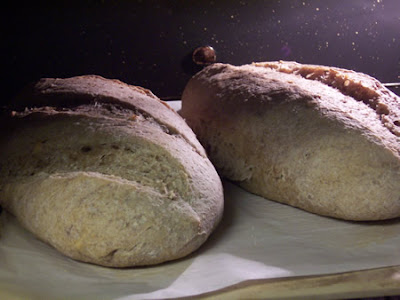I’ve heard a lot about the benefits of Quinoa and have wanted to try it for awhile. This Quinoa Bread is one of the breads that was listed for the HBinFive September 15th Bread Braid, but I didn’t have any Quinoa at the time so I postponed making it. The other HBinFive Bakers raved about this bread so I got some Quinoa grains and set out to see for myself what all the fuss was about.
If you’re not familiar with the benefits of Quinoa, here’s a little background info:
“Quinoa was of great nutritional importance in pre-Columbian Andean civilizations, being secondary only to the potato, and was followed in importance by maize. In contemporary times, this crop has become highly appreciated for its nutritional value, as its protein content is very high (12%–18%). Unlike wheat or rice (which are low in lysine), and like oats, quinoa contains a balanced set of essential amino acids for humans, making it an unusually complete protein source among plant foods. It is a good source of dietary fiber and phosphorus and is high in magnesium and iron. Quinoa is gluten-free and considered easy to digest.” http://en.wikipedia.org/wiki/Quinoa
Quinoa has a light, fluffy texture when cooked, and a mild, slightly nutty flavor. It looks and smells like sesame seeds to me. I love sesame seeds so I thought if it tastes as good as it smells, then we would have a winner.
Look for the recipe for this delicious Quinoa Bread on page 132 of the Healthy Bread in Five Minutes book. You can also find some of the Healthy Bread in Five Minutes recipes on Google Reader.
I halved the recipe so I used a mixture of 1 1/2 cups of white whole wheat, 1 3/4 cups of all-purpose flour and 1/2 cup of uncooked quinoa grains along with some yeast, vital wheat gluten, kosher salt, and water for the dough. Since it’s a multigrain bread, I thought it would bake well in my clay bread pot. It turned out to be a beautiful golden-brown color and the crust is delicious!
I was not disappointed. This Quinoa Bread does taste as good as it smells and it’s good for you. Can’t beat that!
Thanks for joining me in the bread-baking blog. This bread has been YeastSpotted. Please visit Wild Yeast to view all of the lovely breads in the roundup.
Be sure to check out BigBlackDog to see all of the breads in the October 1st Bread Braid roundup.

About the HBinFive Baking Group
The HBinFive Baking Group, started by Michelle of Big Black Dogs, is baking through all of the breads in the Healthy Bread in Five Minutes book. For more information on the HBinFive baking group, check out BigBlackDog.














































 The Mellow Bakers group was started by Paul at
The Mellow Bakers group was started by Paul at 













